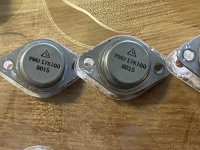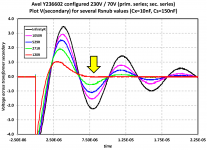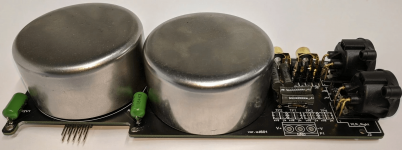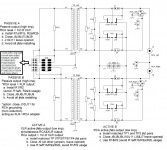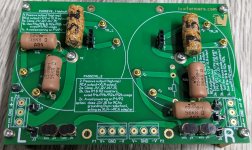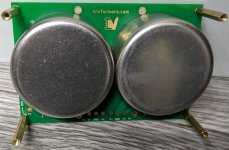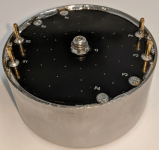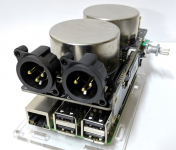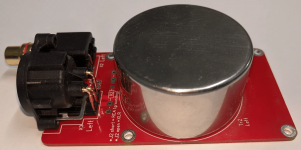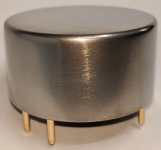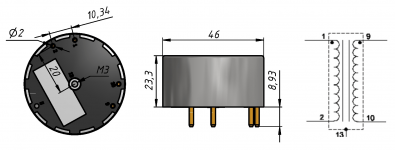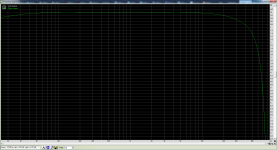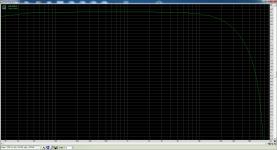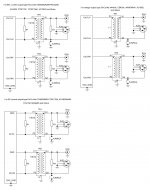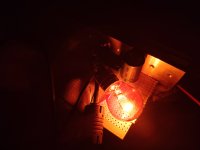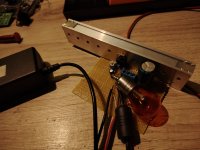Live Edge Dipoles: 2023 Upgrade Advanced Application Notes
The Live Edge Dipoles took 1st Place at the Parts Express Speaker Design Competition August 4-5 in Ohio. 59 contestants. My Open Baffle design on a slab of live edge birch won top score in the Open Unlimited category.
Judge Jerry McNutt said, “The best way to not sound like a box is: Don’t use a box.” Listener comments: The Beryllium tweeters are extremely transparent; bass is rich, expansive and authoritative; thorough top-to-bottom coherence and integration; warm, ambient and enveloping stereo image. Can effortlessly fill a large room to overflowing with palpable output and dynamic range.
I hosted the Chicago Audio Society a few weeks prior. Listeners were consistently impressed not only with rock and jazz but string quartets and large orchestral works. One listener said they combine the open, room-filling sound of Magnepans with the slam and dynamics of a JBL. Sound stage is
huge.
The Live Edge Dipoles were featured on the cover of AudioXpress January 2021. The article there provides a thorough description of the system as it was at the time:
https://audioxpress.com/article/you-can-diy-perry-marshall-the-live-edge-dipoles or
tinyurl.com/LiveEdgeDipolesAudioXpress.
I have since made numerous upgrades. Before I dive into details, a few insights about speaker design; and why, out of thousands of possible choices, I selected the format I used here.
Why ordinary speakers are doomed
When you visit any audio show, 90% of the speakers share the same weary collection of baked-in assumptions:
- They all have boxes
- They all sound boxy
- Wife Appreciation Factor is low or sub-zero
- Simulated woodgrain finish
- On-axis frequency response is obsessed about
- Off-axis response is ignored
- Radiation pattern is ignored
- Bass is omnidirectional
- Drivers interfere with each other
- They have 1” dome tweeters
- Crossovers butcher impulse and phase response
- There is one “center of the will of God” sweet spot
- The room is ignored (and room acoustics are voodoo)
- Inefficient: 1 watt / 1 meter is often mid- to low-80s
- Hard for amps to drive because of extreme impedance variations
- Drivers are small and sound anemic with real (non-audiophile) music
This consigns you to one predictably boring demo room after another. The Live Edge Dipoles sidestep every pitfall listed above. Giant notes roll out of the speakers. You enjoy a huge sound stage. You are immersed in 3D ambience, clarity and resolution. Dry recordings become spacious. Drums and toms hit with visceral, fist-on-sternum impact.
I don’t believe
vocals are the toughest thing to get right in a speaker.
Percussion is the hardest! Especially with other instruments. Most speakers fail to excel at percussion because they butcher time response; you can easily measure it.
Check the sidebar that reports Step Response in every Stereophile review and witness the butchering with your own eyes. Woofers and tweeters fire with opposite polarities on different dates.
Average speaker designers claim you can’t hear the difference. I insist you can. Once you hear the “boxiness” of box speakers, you can’t un-hear it.
With the Live Edge Dipoles, the most delicate of sounds, the wires and shell of a snare drum, are reproduced the startling precision. When the drummer slams the floor tom (like in “Hatesong” by Porcupine Tree), you feel it in your bones.
40 Years of Design
My early teenage years were, shall we say, less than fun. I escaped into Audio projects. I fell in love with a pair of Boston Acoustics A60s but couldn’t afford ‘em. Laid my hands on a McGee catalog and made my own with a Peerless polypropylene woofer and the same Tonegen tweeter as the A60s.
I sold my first pair of speakers to a paying customer when I was 14. I briefly sold my own brand through a local dealer alongside B&W, Denon and PS Audio when I was a senior in high school. Then an Electrical Engineering degree with accent on Control and Communication Systems. Worked as an acoustical engineer for 3 years at Jensen designing OEM drivers for Honda, Ford, Chrysler and Acura.
Since then, audio has been my hobby, with occasional articles in Voice Coil and AudioXpress. I’ve made almost every type including acoustic suspension, reflex, bandpass, transmission line, horn, dipole, ribbon and shaded arrays. I’ve built Motional Feedback subwoofers and used active, passive, analog and digital crossovers. Homes, cars, churches, studios and live bands.
A memorable leap in my journey as a speaker designer was my first Open Baffle design using 12” Faital coaxials. The huge size of soundstage and the lack of boxiness made a striking impression on me, playing quiet classical guitar music at 7 o’clock in the morning. The energy of pro-sound drivers without compression sealed the deal.
Radiation Pattern
Polar pattern is one of the great underappreciated secrets of great speaker design, and it’s a secret to these speakers’ performance. The capacity to deliver low distortion, flat frequency response, transient response, etc. is admirable. But to achieve an excellent distribution pattern at the same time separates the men from the boys. When response is only flat on-axis, your design will sound more like a speaker and less like real music.
When room reflections don’t match direct sound from the speaker, it sounds unnatural. Textbook speaker designs pretend the room is not there. But not only does the bass have room modes and standing waves, but the mid and high frequency reflections add LOTS of clues for your ears. Good clues make your ears happy.
PERFORMANCE SUMMARY
- 30Hz to 25KHz with silky-smooth response in a real room that has real reflections. Not just in an anechoic chamber.
- True Constant Directivity sound pattern 30Hz to 25KHz so imaging is superb anywhere in the room
- Open Baffle Dipole sounds great even behind the speakers
- High Efficiency – 95dB 1 watt/1 meter. Sounds great and plays loud even with “flea watt” single ended vacuum tube amps
- High Power Handling and High Output – 100 watts & 115 dB running full range; 500 watts & 120 dB with subwoofer
- Near-perfect impulse response
- Near-perfect phase response
- Low Distortion (<2% above 60Hz; <1% above 150Hz at 90dB)
- Easy to drive
- Live Edge wood is so beautiful, non-audiophile wives of non-audiophile men gasped when I showed these on a screen in a Zoom meeting.
- 3-way system is bi-amped (not tri-amped) using a MiniDSP 2x4HD.
The Live Edge Dipoles exhibit true Constant Directivity from 20Hz to 20KHz on
both sides of the speaker. Full dipole behavior front and back with a Figure-8 radiation pattern. Constant Directivity means the speaker is
consistently directional. Much louder on axis than off, and levels drop consistently across the whole range as you move off axis, instead of only dropping at the top end of the woofer and tweeter’s range.
Above: Polar spectrum of the Live Edge Dipoles, 150Hz-15KHz. Beamwidth is defined as -6dB points relative to 0 degrees, which is the cyan color in the graph. Beamwidth stays between +/-30 and +/-60 degrees across the entire range.
Above: Frequency response in a real room at 0, 15, 30, 45, 60, 75 and 90 degrees. The number of commercially available speakers that come close to these off-axis curves, you can count on one hand. I discuss the polar pattern below. They have a rear-firing “ambience” tweeter which makes the rear radiation very similar to the front. To my ears, dipoles without this don’t sound right. A level pad lets you tailor the ambience to taste.
A true Constant Directivity speaker yields good stereo imaging even if you are standing right next to one of the two speakers. It delivers outstanding sonic images to every seat in the house. When arranged in a triangle pattern with the speakers pointed towards the listener position, every seat sounds great.
Great Stereo Image Everywhere
Below is a crayon drawing of a room with Constant Directivity Dipoles. It shows why Open Baffles with uniform response, toed in about 30 degrees, image better than every other type of speaker.
Stereo imaging is strong anywhere inside the yellow boundary, starting at
A.
B, right in front of one speaker, is the only spot where imaging isn’t good.
When you stand at
C you hear the right speaker across the room just as well as the left. And yes, you get a decent stereo image there.
Same is true even at
D. You can hear the right speaker clearly, even standing just
behind the left speaker.
There are no sidewall reflections at the wall near
C because it’s in the null plane of the dipole.
1,
2,
3 and
4 illustrate that rear radiation reflects from the wall back into the room. This provides ambience but does not override direct sound.
The “sweet spot” is somewhere between
F and
G, depending on how “headphone-like” you want your sound.
Place your turntable at
T, the null for both speakers. Cuts acoustic feedback 10-15dB.
As you walk from
C to
E to
H, the stereo image remains stable and the volume grows louder.
E and
H, though much farther away, are louder than
C because the directivity pattern is so well-controlled.
Very few speakers do any of this. To my knowledge the number of available commercial designs that achieve constant directivity across the entire spectrum is zero.
Above: Frequency response of the Live Edge Dipoles, on axis at 1.5 meters in my room. No attempt to gate or eliminate room reflections. Room response should taper downward slightly as frequency rises. Some speakers measure more perfectly in an anechoic chamber… but these measure
very well in real rooms. Not just in one spot but
everywhere in the room! This EQ sounds most neutral to my ears.
In this design I optimized the
physical design and shape for radiation pattern, and then I corrected the problems this incurred with Digital Signal Processing.
Upgrades Since the 2021 AudioXpress article:
- I upgraded the aluminum dome in the Radian 5208C to beryllium. The beryllium has very similar frequency response but sounds quite a bit different. Extremely clear and transparent. Sounds “buttery transparent” and not analytical. The tweeter just disappears.
- I changed the tweeter wiring and several EQ settings in the DSP crossover.
- I added Bass EQ options. The stock design is flat down to below 30Hz. This is great for small rooms and listeners who are not “bass heads.” However, if you push them super hard with lots of deep bass, the subs will complain. I added a “Rock and Roll” EQ setting that rolls off below 35Hz. With this setting you can play loud music in a large room and the speakers will handle the full dynamic range without effort.
Aluminum vs Beryllium
The standard version with aluminum dome sounds fantastic and I have no criticisms. Though the beryllium diaphragms cost several hundred dollars apiece, they are well worth the dinero. They deliver extreme transparency similar to ribbons and electrostatics, without harshness. The tweeters just disappear and let the music flow through. Finally, they’re not merciless. Many high-def speakers are harsh and unforgiving of ordinary recordings, but the Rolling Stones and AC/DC sound great too.
High SPL Drivers, Amps and DSPs
The Eminence 18 Kappa LF woofers produce 98dB SPL / 1W. The Radian 5208 coax puts out 95dB from the woofer section and ~100dB from the 16-ohm tweeter section.
High efficiency makes them extremely sensitive to electronic hum and noise. Amps with noise and grounding problems, not evident in typical 85-90dB audiophile speakers, are exposed. Furthermore, the MiniDSP 2x4HD has some noise which is not obvious with most speakers, but evident with high efficiency horns.
You can solve this by using an amp with an input control and turning it down a bit (Adcom GFA2535 is a great 4 channel amp and has level controls) or with a padding device like a Harrison Labs 12dB attenuator.
An even better solution is the MiniDSP Flex Eight, which has higher resolution and lower noise floor. I have configuration files for this too, discussed below. I further minimized the noise problem by wiring the rear tweeter (PRV WG175PH) and front tweeter in series, with parallel resistor networks bringing the total impedance down to 11 ohms. This tames the tweeter output to 95dB.
Only the most basic functions are performed by passive components: 200Hz crossover between woofer and midrange; tweeters are wired in series with an L-pad for adjusting level of the rear tweeter; a 20uF capacitor simply protects the tweeters from accidents. All heavy lifting is done by the DSP with 2KHz crossover with FIR phase correction.
Noise sensitivity notwithstanding, the energy, dynamic range and effortless performance you get from efficient pro drivers like Eminence and Radian more than compensate for the noise precautions you have to take. Speakers with vast dynamic range and low distortion sound so effortless and open, you feel compelled to crank the volume up.
Most audiophiles are so conditioned to buckets of intermodulation distortion, they’re stunned when a system doesn’t have it. I call it “Dynamic range to burn.” Once you’ve experienced it, you never go back.
The “Lambda Slab” U-Frame
The triangular sides on the bottom of the cabinet on each side of the 18” woofer pushes the dipole roll off frequency lower. Without them the roll off would start around 100Hz; with them it’s around 60Hz. The wings buy you almost an octave of bass.
It’s easy to get deep bass from an Open Baffle speaker… you just need a Digital Signal Processor and heavy EQ. You pay a price, however, which is that your woofer can easily bottom. Distortion spikes at low frequencies. I have paid close attention to this issue. The bass EQ begins in earnest below 60Hz. This is the curve for the standard “Jazz EQ” DSP file:
Above: EQ reaches 20dB at 29Hz, then rolls off gently below. Yep, 20dB is a ton of EQ, but remember that these have 95-98dB sensitivity, so across 90% of the spectrum they require very little power. Extra power is only demanded by occasional deep bass passages.
I call this the Jazz EQ setting. It’s optimized for lowest group delay and least ringing in the step response. Most speakers have gobs of phase shift at low frequencies which you easily hear on well recorded bass drums. The steeper the filter, the more phase shift. Steep slopes like in actively assisted 6th order reflex designs add many tens of milliseconds of phase delay. This design sidesteps that.
Above: Phase is +/-30 degrees from 40Hz to 20KHz with a max of only 120 degrees around 20-30Hz. Very, very few speakers match this. This cuts group delay and maximizes bass resolution.
Above: Step response. Fast rise time followed by steady descent with no phase reversals. Drivers fire in perfect time with each other. There is little low frequency ringing because the design minimizes phase shift and group delay. Very few speakers match this. This is one reason why clarity and imaging are so precise.
Above: Impulse response. Most speakers shred impulses, which should look like an upside down “T.” The Live Edge Dipoles deliver 80% of their energy in a tight 0.1 millisecond slice. This makes lightning fast transients and exquisite detail.
Bass from most subs, even celebrated designs, sounds more like well-articulated thumps than genuine instruments. Open Baffle speakers bring a welcome exception and sound extremely natural. The Jazz EQ setting achieves flat response to below 30Hz with minimum phase delay. Perfect for listeners with small rooms and / or do not demand the pantleg-flapping bass of car stereo shows and rave clubs.
However if you have a big room and/or want to shake the house with loud rock or electronic music, I added a 2nd EQ configuration file called “Rock & Roll EQ” that adds a dual shelf filter (instead of standard high pass) at 35Hz, with a slight lift between 40-60Hz and above 5KHz:
With this one tweak, the speaker can play 10dB louder than the Jazz setting. So if you like your music loud, even in a large room, this EQ setting will keep your woofers from bottoming or wincing in pain.
Above: Low frequency drive signal from amp. Blue = Jazz EQ. Orange = Rock & Roll EQ. Reduces woofer excursion by 70%, allowing up to 10dB greater output.
This matters in an Open Baffle design. That’s because an acoustic suspension woofer’s max output falls at the rate of 12dB per octave. That is challenging enough if you’re trying to shake the house. But an Open Baffle woofer loses traction at the rate of 18dB per octave (12dB from standard radiation resistance, plus an extra 6 dB due to rear wave cancellation). So every 1/3 octave of bass you ask of an Open Baffle speaker demands +6dB which requires 2X the excursion and 4X the power. One full octave costs you 18dB: 8X excursion and 64X power!
By relieving the 18” woofer of everything below 35Hz, you buy yourself 10dB more dynamic range. The 18” Eminence woofers, bolstered by the U-frame wings and 35Hz roll off on the Rock & Roll EQ, use 14dB of boost at 39Hz and generate high SPLs without effort. You can load both settings into your MiniDSP 2x4 HD and switch between them at will.
Low Distortion
Below: Distortion measured at mid-band output of 90dB SPL/1M in a real room; SPL climbs to 100dB at 40Hz. This is with the Rock & Roll EQ setting. Distortion is under 2% above 60Hz, under 1% above 150Hz. (Data also includes rattles and buzzes of the room itself.) The darker curve is 2nd order, lighter 3rd order:
(continued in next post)









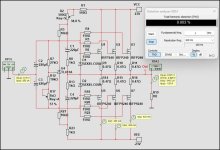
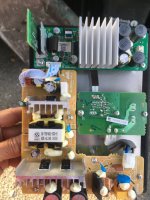





































 :
:




